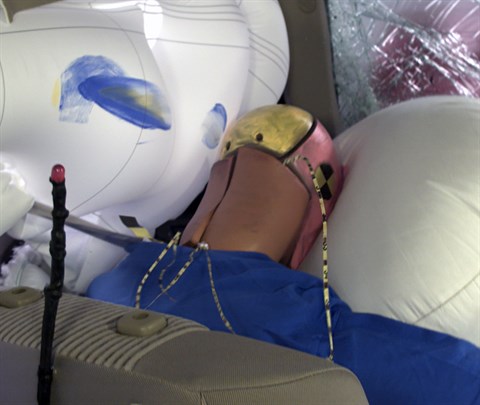Small overlap front
The small overlap front evaluation consists of a driver-side and a passenger-side component. This vehicle has an incomplete rating because it has been tested only on one side.
Driver-side
- Rating applies to 2014-24 models
Tested vehicle: 2014 Toyota 4Runner SR5 4-door 4wd
The Toyota 4Runner was redesigned for the 2010 model year. Beginning with 2014 models, the side curtain airbags were lengthened and reprogrammed to deploy in frontal crashes (in addition to side and rollover crashes) to improve occupant protection.
| Evaluation criteria | Rating |
|---|---|
| Overall driver-side evaluation | |
| Structure and safety cage | |
| Driver injury measures | |
| Head/neck | |
| Chest | |
| Hip/thigh | |
| Lower leg/foot | |
| Driver restraints and dummy kinematics | |

Action shot taken during the small overlap frontal crash test.

The dummy's position in relation to the door frame, steering wheel, and instrument panel after the crash test indicates that the driver's survival space was not maintained well.

The frontal and side curtain airbags worked well together to keep the head from coming close to any stiff structure or outside objects that could cause injury, even though the steering column moved slightly too far to the right.

Door hinge pillar and instrument panel intrusion was extensive and contributed to a moderate risk of injuries to both lower legs.
Moderate overlap front: original test
Rating applies to 2010-24 models
Tested vehicle: 2010 Toyota 4Runner SR5 4-door 4wd
The Toyota 4Runner was redesigned for the 2010 model year. Frontal ratings are assigned by the Institute based on a test conducted by Toyota.
| Evaluation criteria | Rating |
|---|---|
| Overall evaluation | |
| Structure and safety cage | |
| Driver injury measures | |
| Head/neck | |
| Chest | |
| Leg/foot, left | |
| Leg/foot, right | |
| Driver restraints and dummy kinematics | |
Side: original test
Rating applies to 2014-24 models
Tested vehicle: 2014 Toyota 4Runner SR5 4-door 4wd with standard head curtain airbags for all three rows of seats and standard front seat-mounted torso airbags
The Toyota 4Runner was redesigned for the 2010 model year. Beginning with 2014 models, design changes were made to the side curtain airbags. Side ratings are assigned by the Institute based on a test conducted by Toyota. However, because there were no side structural changes, the structure rating of the current model is based on both this test and an earlier test conducted by Toyota of a 2010 model.
| Evaluation criteria | Rating |
|---|---|
| Overall evaluation | |
| Structure and safety cage | |
| Driver injury measures | |
| Head/neck | |
| Torso | |
| Pelvis/leg | |
| Driver head protection | |
| Rear passenger injury measures | |
| Head/neck | |
| Torso | |
| Pelvis/leg | |
| Rear passenger head protection | |
Child seat anchors
Rating applies to 2017-24 models
| Evaluation criteria | Rating |
|---|---|
| Overall evaluation | |
| Vehicle trim | SR5 |
| Seat type | cloth |
This vehicle has 2 rear seating positions with complete child seat attachment (LATCH) hardware.
It has 1 additional seating position with a tether anchor only.
| Evaluation criteria | Rating |
|---|---|
| Overall evaluation | |
| Vehicle trim | SR5 |
| Seat type | cloth |
| Rating icon | Rating |
|---|---|
| G | Good |
| A | Acceptable |
| M | Marginal |
| P | Poor |
| Seating positions that rely on borrowed lower anchors or have only a tether anchor available are not rated. | |
thether anchor symbol | Tether anchor |
lower anchor symbol | Lower anchors |
| Lower anchor(s) can be borrowed from adjacent positions(s) | |
| No hardware available |
Details by seating position
| Position | Rating |
|---|---|
| 1 | |
| Tether anchor | |
| easy-to-find location | |
| other hardware could be confused for anchor | |
| Lower anchors | |
| too deep in seat | |
| too much force needed to attach | |
| easy to maneuver around anchors | |
| 2 | |
| Tether anchor | |
| easy-to-find location | |
| other hardware could be confused for anchor | |
| Lower anchors | |
| none available | |
| 3 | |
| Tether anchor | |
| easy-to-find location | |
| other hardware could be confused for anchor | |
| Lower anchors | |
| too deep in seat | |
| too much force needed to attach | |
| easy to maneuver around anchors |
